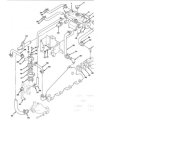I got my port side shaft aligned and was able to get out at cruise speed. If you can recall my last post where the whole cooling system is new on both engines, here are the actual numbers. I ran all last year like this and it never overheated but just isn't right. All of the work was done last off season, nothing recent other than new seacocks and raw water scoops. Same results as last year though.
The port side gauge shoots up really fast. Within a few minutes of idling it's reading 160 where the Stb side is maybe 120. After running for about 1/2 hour and 10-15 mins at 3,000+, here are the numbers:
Gauge reading 168 - thermostat housing is 157 (measured at the base this time instead of the bleed screw which is more accurate)
Exh manifolds are both 175
Risers/elbows are both in the low 100's
Both u-coolers hoses are (IN/OUT) are in the 70's (close to water temp)
Hose into the H/E is 150-160 where the Stb side is around 130
Hose into the manifold is 135 and 170 coming OUT (hatch was on so only able to shoot one side).
There's about a 25-40 degree difference between the exhaust manifolds on each engine. The riser/elbow temps are somehow in the same range on each side though.
The other thing I noticed is a lot of air bubbles and swirling of the water in the strainer site glass. The other side was full of water but you couldn't really "see" it like the port/hot side. It's a straight connection from the raw water intake and into the strainer. Hoses are new and clamps are tight.
The raw water flow out of the exhaust seems to be about the same. Hard to tell at speed on my boat because the exhaust is partially underwater.
At WOT, the port engine gets to about 190, Starboard is a little over 170.
Engines are FWC, 454's, 1988. I can post the Stb side numbers but they seem to be ok all around.
Any ideas?
Bob
The port side gauge shoots up really fast. Within a few minutes of idling it's reading 160 where the Stb side is maybe 120. After running for about 1/2 hour and 10-15 mins at 3,000+, here are the numbers:
Gauge reading 168 - thermostat housing is 157 (measured at the base this time instead of the bleed screw which is more accurate)
Exh manifolds are both 175
Risers/elbows are both in the low 100's
Both u-coolers hoses are (IN/OUT) are in the 70's (close to water temp)
Hose into the H/E is 150-160 where the Stb side is around 130
Hose into the manifold is 135 and 170 coming OUT (hatch was on so only able to shoot one side).
There's about a 25-40 degree difference between the exhaust manifolds on each engine. The riser/elbow temps are somehow in the same range on each side though.
The other thing I noticed is a lot of air bubbles and swirling of the water in the strainer site glass. The other side was full of water but you couldn't really "see" it like the port/hot side. It's a straight connection from the raw water intake and into the strainer. Hoses are new and clamps are tight.
The raw water flow out of the exhaust seems to be about the same. Hard to tell at speed on my boat because the exhaust is partially underwater.
At WOT, the port engine gets to about 190, Starboard is a little over 170.
Engines are FWC, 454's, 1988. I can post the Stb side numbers but they seem to be ok all around.
Any ideas?
Bob
Last edited:


